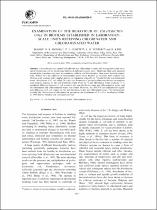 ResearchSpace
ResearchSpace
Examination of the behaviour of escherichia coli in biofilms established in laboratory- scale units receiving chlorinated and chloraminated water
JavaScript is disabled for your browser. Some features of this site may not work without it.
- ResearchSpace
- →
- Research Publications/Outputs
- →
- Journal Articles
- →
- View Item
| dc.contributor.author |
Momba, MNB

|
en_US |
| dc.contributor.author |
Cloete, TE

|
en_US |
| dc.contributor.author |
Venter, SN

|
en_US |
| dc.contributor.author |
Kfir, R

|
en_US |
| dc.date.accessioned | 2007-02-07T06:07:26Z | en_US |
| dc.date.accessioned | 2007-06-07T10:03:50Z | |
| dc.date.available | 2007-02-07T06:07:26Z | en_US |
| dc.date.available | 2007-06-07T10:03:50Z | |
| dc.date.copyright | en_US | |
| dc.date.issued | 1999-09 | en_US |
| dc.identifier.citation | Momba, MNB, et al. 1999. Examination of the behaviour of escherichia coli in biofilms established in laboratory- scale units receiving chlorinated and chloraminated water. Water Research, vol 33(13), pp 2937-2940 | en_US |
| dc.identifier.issn | 0043-1354 | en_US |
| dc.identifier.uri | http://hdl.handle.net/10204/1573 | en_US |
| dc.identifier.uri | http://hdl.handle.net/10204/1573 | |
| dc.description.abstract | Groundwater was treated with chlorine and chloramine to study the incorporation and survival of Escherichia coli (E. coli) in developing biofilms in laboratory-scale units. Membrane filter and standard spread plate procedure were used to enumerate coliform and heterotrophic plate count bacteria respectively. Within 96 hours the adhesion of heterotrophic plate count bacteria on stainless steel coupons was obvious in all systems, with a higher number of organisms (4 log cfu cm-2) noted for the non-disinfected water. Attachment of E. coil added 24 hours after the formation of young biofilms was obvious on stainless steel coupons exposed to the non-disinfected water (9 cfu cm-2) and chlorinated water (2 cfu cm-2). A significant difference between E. coil counts in the non-disinfected water and chloraminated water, and the chlorinated and chloraminated water, was found. The ANOVA test indicated no significant difference in E. coil counts for the non-disinfected water and chlorinated water. This investigation revealed the effectiveness of chloramine in preventing the attachment of E. coil in developing biofilm, and in controlling the growth of attached heterotrophic bacteria | en_US |
| dc.format.extent | 120332 bytes | en_US |
| dc.format.mimetype | application/pdf | en_US |
| dc.language.iso | en | en_US |
| dc.publisher | Pergamon-Elsevier Science Ltd | en_US |
| dc.rights | Copyright: 1999 Elsevier Science Ltd | en_US |
| dc.source | en_US | |
| dc.subject | Chlorinated water | en_US |
| dc.subject | Chloraminated water | en_US |
| dc.subject | Opportunistic pathogens | en_US |
| dc.subject | Biofilms | en_US |
| dc.subject | Escherichia coli | en_US |
| dc.subject | Environmental sciences | en_US |
| dc.title | Examination of the behaviour of escherichia coli in biofilms established in laboratory- scale units receiving chlorinated and chloraminated water | en_US |
| dc.type | Article | en_US |
| dc.identifier.apacitation | Momba, M., Cloete, T., Venter, S., & Kfir, R. (1999). Examination of the behaviour of escherichia coli in biofilms established in laboratory- scale units receiving chlorinated and chloraminated water. http://hdl.handle.net/10204/1573 | en_ZA |
| dc.identifier.chicagocitation | Momba, MNB, TE Cloete, SN Venter, and R Kfir "Examination of the behaviour of escherichia coli in biofilms established in laboratory- scale units receiving chlorinated and chloraminated water." (1999) http://hdl.handle.net/10204/1573 | en_ZA |
| dc.identifier.vancouvercitation | Momba M, Cloete T, Venter S, Kfir R. Examination of the behaviour of escherichia coli in biofilms established in laboratory- scale units receiving chlorinated and chloraminated water. 1999; http://hdl.handle.net/10204/1573. | en_ZA |
| dc.identifier.ris | TY - Article AU - Momba, MNB AU - Cloete, TE AU - Venter, SN AU - Kfir, R AB - Groundwater was treated with chlorine and chloramine to study the incorporation and survival of Escherichia coli (E. coli) in developing biofilms in laboratory-scale units. Membrane filter and standard spread plate procedure were used to enumerate coliform and heterotrophic plate count bacteria respectively. Within 96 hours the adhesion of heterotrophic plate count bacteria on stainless steel coupons was obvious in all systems, with a higher number of organisms (4 log cfu cm-2) noted for the non-disinfected water. Attachment of E. coil added 24 hours after the formation of young biofilms was obvious on stainless steel coupons exposed to the non-disinfected water (9 cfu cm-2) and chlorinated water (2 cfu cm-2). A significant difference between E. coil counts in the non-disinfected water and chloraminated water, and the chlorinated and chloraminated water, was found. The ANOVA test indicated no significant difference in E. coil counts for the non-disinfected water and chlorinated water. This investigation revealed the effectiveness of chloramine in preventing the attachment of E. coil in developing biofilm, and in controlling the growth of attached heterotrophic bacteria DA - 1999-09 DB - ResearchSpace DP - CSIR KW - Chlorinated water KW - Chloraminated water KW - Opportunistic pathogens KW - Biofilms KW - Escherichia coli KW - Environmental sciences LK - https://researchspace.csir.co.za PY - 1999 SM - 0043-1354 T1 - Examination of the behaviour of escherichia coli in biofilms established in laboratory- scale units receiving chlorinated and chloraminated water TI - Examination of the behaviour of escherichia coli in biofilms established in laboratory- scale units receiving chlorinated and chloraminated water UR - http://hdl.handle.net/10204/1573 ER - | en_ZA |





